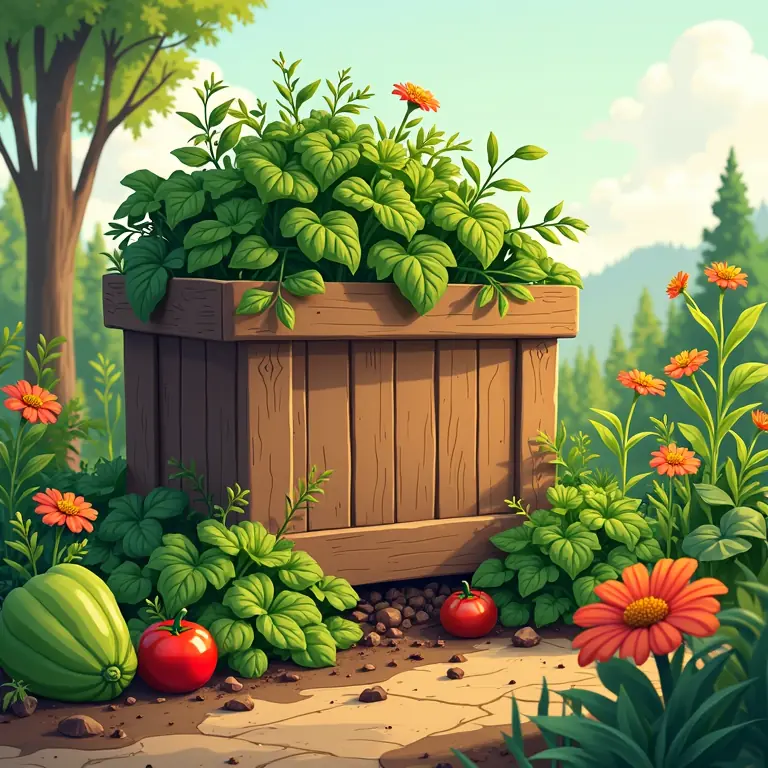Build Your Own Compost: A Friendly Guide to Black Gold
Composting. The word itself might conjure images of messy piles and unpleasant smells. But what if I told you that composting is actually a remarkably simple, incredibly beneficial, and surprisingly rewarding process? It’s a way to turn your kitchen scraps and yard waste into a nutrient-rich “black gold” that will supercharge your garden, reduce your environmental impact, and save you money. This guide will walk you through everything you need to know to build your own compost system, from the basic principles to troubleshooting common problems. Let’s get started!
What *Is* Composting, Anyway?
At its core, composting is nature’s recycling process. When leaves fall, plants die, and animals… well, you know… they decompose. This decomposition is carried out by a vast army of microorganisms – bacteria, fungi, and other tiny creatures – that break down organic matter into simpler substances. Composting simply mimics this natural process in a controlled environment. Instead of letting your organic waste languish in a landfill, where it contributes to greenhouse gas emissions, you’re harnessing the power of these microorganisms to create a valuable resource for your garden.
The end result? Humus – a dark, crumbly, earthy-smelling substance packed with nutrients. This isn’t just “dirt”; it’s a soil amendment that improves soil structure, water retention, and fertility. Plants *love* it!
Why Compost? The Benefits Are Abundant
- Enrich Your Garden: Compost provides essential nutrients for plant growth, reducing the need for chemical fertilizers.
- Improve Soil Health: Compost improves soil structure, making it easier for roots to grow and access water and nutrients. It also helps sandy soil retain water and clay soil drain better.
- Reduce Landfill Waste: A significant portion of household waste is organic material. Composting diverts this waste from landfills, reducing methane emissions and conserving landfill space.
- Save Money: Less need for fertilizers and potentially less need for watering – composting can save you money over time.
- Environmentally Friendly: Composting is a sustainable practice that reduces your carbon footprint and supports a healthier planet.
The Ingredients of Successful Compost: Greens and Browns
Composting isn’t just about throwing everything into a pile and hoping for the best. It’s about creating the right balance of ingredients. These ingredients are broadly categorized as “greens” and “browns.”
Greens: Nitrogen-Rich Materials
“Greens” provide nitrogen, which is essential for the microorganisms to thrive. They tend to be wet and decompose quickly. Examples include:
- Fruit and vegetable scraps
- Coffee grounds and filters
- Tea bags (remove staples)
- Fresh grass clippings
- Manure (from herbivores like cows, horses, chickens – use cautiously and in moderation)
- Plant trimmings
Browns: Carbon-Rich Materials
“Browns” provide carbon, which serves as an energy source for the microorganisms. They tend to be dry and decompose more slowly. Examples include:
- Dried leaves
- Shredded paper and cardboard (avoid glossy or colored paper)
- Straw and hay
- Wood chips and sawdust (use sparingly)
- Small twigs and branches
The Ideal Ratio: The sweet spot is generally around 2-3 parts browns to 1 part greens. This isn’t an exact science, and you’ll learn to adjust the ratio based on how your compost is progressing (more on that later). Think of it like baking – you need the right balance of ingredients for the best results.
Choosing a Composting Method: Which One is Right for You?
There are several ways to compost, each with its own advantages and disadvantages. Here are some of the most common methods:
1. Compost Pile (Traditional Method)
This is the classic composting method. You simply create a pile of organic materials in your backyard. It’s the most economical option, but it can take longer to produce finished compost and may be less aesthetically pleasing.
- Pros: Low cost, simple to set up, can handle large volumes of material.
- Cons: Can be slow, may attract pests, requires more space.
2. Compost Bin
Compost bins are enclosed containers that help contain the composting process. They can be made from wood, plastic, or metal. Bins offer better temperature control and can be more visually appealing than a simple pile.
- Pros: Neater appearance, better temperature control, can deter pests, faster decomposition.
- Cons: More expensive than a pile, may have limited capacity.
3. Tumbler
Tumblers are rotating bins that make turning the compost much easier. Turning is essential for aeration (providing oxygen to the microorganisms), and tumblers simplify this process.
- Pros: Easy to turn, faster decomposition, good aeration, often pest-resistant.
- Cons: Most expensive option, may have limited capacity, can be heavy when full.
4. Vermicomposting (Worm Composting)
This method uses worms (typically red wigglers) to break down organic matter. It’s ideal for indoor composting, especially if you have limited space.
- Pros: Great for small spaces, produces high-quality compost (worm castings), relatively odorless.
- Cons: Requires managing a worm bin, limited to certain types of food scraps, can be sensitive to temperature and moisture.
Building Your Compost Pile: A Step-by-Step Guide
Let’s focus on the traditional compost pile method, as it’s a great starting point. Here’s how to build one:
- Choose a Location: Select a well-drained spot in your yard that’s partially shaded. Avoid areas that become waterlogged.
- Start with a Base: Lay down a layer of twigs and branches to improve aeration.
- Layer Greens and Browns: Alternate layers of greens and browns, starting with a layer of browns. Aim for a thickness of 2-4 inches per layer.
- Water Each Layer: Moisten each layer as you add it. The compost should be damp like a wrung-out sponge.
- Continue Layering: Repeat the layering process until your pile reaches a manageable size (typically 3ft x 3ft x 3ft).
Maintaining Your Compost: Turning, Watering, and Troubleshooting
Once your compost pile is built, it requires some maintenance. Here’s what you need to do:
Turning
Turning the compost pile aerates it, providing oxygen to the microorganisms. This speeds up the decomposition process. Turn the pile every 1-2 weeks. If you’re using a tumbler, simply rotate it.
Watering
Keep the compost pile consistently moist, but not soggy. Check the moisture level regularly and add water as needed.
Troubleshooting Common Problems
- Smell: A foul odor usually indicates a lack of oxygen. Turn the pile more frequently. Adding more browns can also help.
- Slow Decomposition: This can be caused by a lack of nitrogen (greens) or moisture. Add more greens and water.
- Pests: If you’re attracting pests, ensure you’re burying food scraps deeply within the pile. A compost bin can also help deter pests.
- Too Dry: Add water.
- Too Wet: Add browns.
What *Not* to Compost
While many organic materials can be composted, some should be avoided:
- Meat, Fish, and Dairy: These attract pests and can cause unpleasant odors.
- Oils and Fats: These can slow down decomposition and attract pests.
- Diseased Plants: These can spread diseases to your garden.
- Pet Waste: This can contain harmful pathogens.
- Coal or Charcoal Ash: These can contain substances harmful to plants.
- Chemically Treated Wood: These can leach harmful chemicals into your compost.
Harvesting Your Black Gold
After several months (the time varies depending on your composting method and climate), your compost will be ready to harvest. You’ll know it’s finished when it’s dark, crumbly, and smells earthy.
To harvest, you can sift the compost to remove any larger, undecomposed materials. The finished compost can then be used as a soil amendment in your garden, added to potting mixes, or used as a top dressing for your lawn.
Taking Your Composting Journey Further
Composting is a continuous learning process. Don’t be afraid to experiment and adjust your methods based on your observations. There are countless resources available online and at your local library to help you deepen your knowledge.
If you’re interested in learning more about sustainable living and DIY projects, you might find these articles helpful:
- Build a Better Bookshelf: A Friendly Guide to Wood Joining Techniques
- Weave Wonderful Baskets: A Friendly Guide to Traditional Reed Weaving
- Decode Your Handwriting: A Friendly Guide to Graphology Basics
Happy composting! With a little effort, you can turn your waste into a valuable resource and contribute to a healthier planet.


Discussion about this post